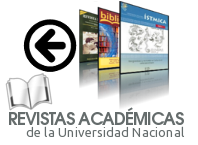Arbitraje y procesamiento de artículos
Article editing and publication process
1. Receipt of articles
The articles are received in the magazine's mailing list: revistasiwo@una.cr
The editor-in-chief confirms receipt of the text, if accompanied by:
- Statement of originality
- Brief curriculum vitae (5 line paragraph including academic degree and e-mail)
- ORCID code
2. Originality check (Turnitin)
A previous revision of the article is carried out to verify its originality. For this purpose, the Turnitin program will be used. (https://www.turnitin.com/)
In addition, the text must contain the following elements:
- Name of author
- University or institution to which he/she belongs
- Title of the text
- Date the document was sent
- Resumen, resumo and abstract (maximum 100 words)
- Palabras clave, palavras chave and Keywords (maximum 5 words)
- Bibliographic and other references
- APA citation format
3. Preliminary formal review
- Once the articles meet the minimum standards, the editor-in-chief will send the documents to the members of the Editorial Board, by e-mail, so that they may give their opinion on them, within a maximum of 15 calendar days.
- A quorum of 5 responses on the approval or rejection of the texts is required to determine their submission to blind peers, or their rejection.
- A quorum of 5 responses on the approval or rejection of the texts is required to determine their submission to blind peers, or their rejection.
- If the Editorial Board indicates the need to make minor substantive changes to the approved article, the Editor-in-Chief will communicate these to the author so that they can be made within a maximum of 15 calendar days.
- If the Board only indicates the need to make some modifications of form, the editor-in-chief will communicate them to the author for correction, simultaneously with the sending of the blind peer review report.
- If the Council indicates the rejection of the article or its thematic relocation to another area of knowledge, the editor-in-chief will inform the author of this fact.
4. Submission to peer reviewers
In case the article is approved by the Editorial Board, the editor-in-chief must contact a blind peer with an academic degree at least equivalent to that of the author, recommended by the Editorial Team, the Editorial Board, the International Advisory Board, or selected by him/her, to evaluate the document and provide his/her observations (according to the respective evaluation form - Checklist), for its approval without changes, its approval with changes, or its rejection, within a maximum period of 22 calendar days.
5. Communication with the author about the evaluation received and possible corrections and adjustments to the approved articles.
The editor-in-chief will send the author the respective opinions, as well as eventual observations of form indicated, in order to make the changes requested by the blind peer, and in accordance with the most recent APA citation manual, within a maximum of 15 calendar days.
6. Philological review
Once the author has made the respective corrections, the editor-in-chief will send, by e-mail, a request to the Publications and Printing Department to carry out the philological revision of the respective issue of Siwô. This e-mail should be sent with a copy to the representative of the Vice Rector's Office for Research and advisor of the UNA journals.
7. Review of the APA system
Once the Publications and Printing Department returns each philologically revised document, the Editor-in-Chief will perform the final review of the APA citation format for each article.
8. DOI creation and submission of articles for layout.
- At this stage, the DOI of each article must be created. Once the DOIs are created, a formal request is made through ITOP for them to be activated for each article.
- Once the articles have the DOI and have been fully reviewed, the editor-in-chief will forward them to the Publications and Printing Department, so that the layout of each text can be done in the following formats: PDF, HTML, EPUB and MP3 (presentation and abstracts).
9. Publication on the Siwô website
The publication of a new issue on the Siwô website includes:
- Creating the new issue.
- Upload the articles in their different formats
- Request DOI activation
The journal is published in PDF, EPUB, HTML and MP3 formats (presentation and abstracts) on the Siwô website, with metadata activation in Open Journal System (OJS3). There, each article must include: abstract, keywords, author's affiliation, Spanish-English-Portuguese option and references (bibliographic and others), to finally publish the journal online.
Siwô magazine has been declared for continuous publication as of September 22, 2021, therefore, articles can be published separately, when they have completed the entire editing process.











